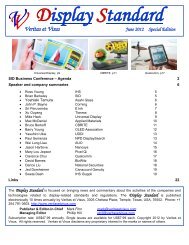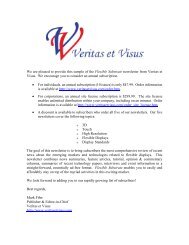Past Editions of “LCD TV Matters” - Veritas et Visus
Past Editions of “LCD TV Matters” - Veritas et Visus
Past Editions of “LCD TV Matters” - Veritas et Visus
Create successful ePaper yourself
Turn your PDF publications into a flip-book with our unique Google optimized e-Paper software.
LCD <strong>TV</strong> Association LCD <strong>TV</strong> Matters May 2012<br />
or the need for an RF technician to install it. Delivering rich content in the form <strong>of</strong> high-definition video has <strong>of</strong>ten<br />
been a challenge for n<strong>et</strong>work managers as it typically means overlaying their twisted-pair infrastructure with an<br />
additional, coaxial infrastructure. Now, with TE’s new system, they have effectively eliminated the time and<br />
expense associated with this additional layer <strong>of</strong> infrastructure. VDS allows anyone to access these services,<br />
including high-definition or IP video, wherever they have a n<strong>et</strong>work outl<strong>et</strong>. The TE Connectivity VDS solution is<br />
TIA-568/ISO 11801 compliant and delivers broadband RF signals over an existing structured cabling<br />
infrastructure. It supports full-spectrum video (862MHz) for up to 295 fe<strong>et</strong> or 550MHz for up to 328 fe<strong>et</strong>. VDS is a<br />
true “plug and play” system for greater ease <strong>of</strong> installation and maintenance and features automatic gain control.<br />
Using self-adjusting baluns to provide amplification and equalization, output and input levels are adjusted to<br />
provide perfect HD video at the <strong>TV</strong> s<strong>et</strong>. The system automatically adjusts the head-end signal for proper system<br />
operation and thereby eliminates the need for manual tuning by solving equalization and balancing issues<br />
traditionally associated with coaxial systems. http://www.te.com<br />
Ooyala report highlights strong growth trends in smart phone, tabl<strong>et</strong> and smart <strong>TV</strong> viewing<br />
Ooyala, a provider <strong>of</strong> digital video technology, analytics and services, published its Q4 2011 Video Index report<br />
revealing insights into video viewing behavior and engagement across the web, smart phones, tabl<strong>et</strong>s, social<br />
n<strong>et</strong>works and connected <strong>TV</strong>s. Each quarter Ooyala provides key insights and trends based on the viewing habits<br />
<strong>of</strong> its more than 100 million viewers every month, to help publishers b<strong>et</strong>ter understand audiences, increase<br />
viewership and earn more revenue with online video. The Video Index report is available in English, French,<br />
Japanese, Portuguese and Spanish to support Ooyala’s broad customer base. Key highlights from the report<br />
include: video plays on tabl<strong>et</strong>s, mobile devices and connected <strong>TV</strong>s nearly doubled in Q4 2011 over Q3 2011; both<br />
iPhone – boosted by the iPhone 4S release in October – and Android grew rapidly quarter-over-quarter in terms <strong>of</strong><br />
videos played and hours watched; Facebook users on average share ten times more video than Twitter users;<br />
video plays on Google <strong>TV</strong> grew 91% in Q4 2011 over Q3 2011; tabl<strong>et</strong> viewers continue to be far more engaged<br />
than desktop viewers – they were 45% more likely to compl<strong>et</strong>e at least 75% <strong>of</strong> videos played, a reliable measure<br />
<strong>of</strong> engagement. Ooyala hosts one <strong>of</strong> the world’s largest video analytics data stores, receiving over 1 billion daily<br />
analytics “pings,” or data queries across more than 110 countries each month. Nearly one in three US online video<br />
viewers use an Ooyala player. Over a hundred million people worldwide tune into Ooyala-powered video to watch<br />
movies, news, live product launches, fashion shows, events such as The Grammys, The Australian Open and<br />
English Premier League football and much more. Ooyala technology measures many aspects <strong>of</strong> viewer<br />
engagement in real time so publishers can act quickly on trending information to maximize revenue via<br />
advertising, pay-per-view transactions, subscriptions, and in the case <strong>of</strong> brand mark<strong>et</strong>ers, increased product sales.<br />
“While people are still watching much more traditional <strong>TV</strong> than streaming video, our data shows we’re on a clear<br />
and irreversible course toward an IP-delivered future,” an executive said. “For example, looking at non-desktop<br />
video views, Q4 was the second straight quarter <strong>of</strong> nearly one hundred percent growth. The Video Index also<br />
shows people are far more engaged on tabl<strong>et</strong>s, which are closer to <strong>TV</strong>s than they are to smart phones when it<br />
comes to viewing behavior.” http://www.ooyala.com<br />
Micros<strong>of</strong>t and N<strong>et</strong>flix form group to promote new streaming media standard<br />
The nascent MPEG DASH streaming media standard got a boost with the<br />
creation <strong>of</strong> the DASH Promoters Group. The standard, which stands for<br />
dynamic adaptive streaming over HTTP, was ratified in November and it enables media streamed over the Intern<strong>et</strong><br />
to dynamically adapt to changing n<strong>et</strong>work conditions. Its goal is to optimize the video streaming experience for end<br />
users. According to a release issued by the DASH Promoters Group, the new standard “incorporates all <strong>of</strong> the<br />
best elements <strong>of</strong> propri<strong>et</strong>ary adaptive streaming solutions designed to solve the classic issues users see when<br />
they stream video: intermittent stalls, poor video quality under changing n<strong>et</strong>work conditions, and significant video<br />
start-up lag.” Participating in the promoter’s group are founding members Micros<strong>of</strong>t, N<strong>et</strong>flix, and Qualcomm. Other<br />
participants include Adobe, AEG Digital Media, Akamai, BuyDRM, Digital Rapids, Digital <strong>TV</strong> Labs, Dolby, EBU-<br />
UER, Elemental, Envivio, Ericsson, Harmonic, Intertrust, NDS, Pack<strong>et</strong> Ship, Path1, RGB N<strong>et</strong>works, Samsung,<br />
Thomson, University <strong>of</strong> Klagenfurt, and ZiXi. One <strong>of</strong> the first activities <strong>of</strong> the new group was a live MPEG-DASH<br />
interoperability demo at the M<strong>et</strong>ro World Congress event in Barcelona. In addition to promoting broad adoption <strong>of</strong><br />
DASH, the Promoters Group also said it will focus on aligning ongoing DASH standards development, promoting<br />
the use <strong>of</strong> common pr<strong>of</strong>iles across industry organizations, and facilitating further interoperability tests. The group is<br />
14






